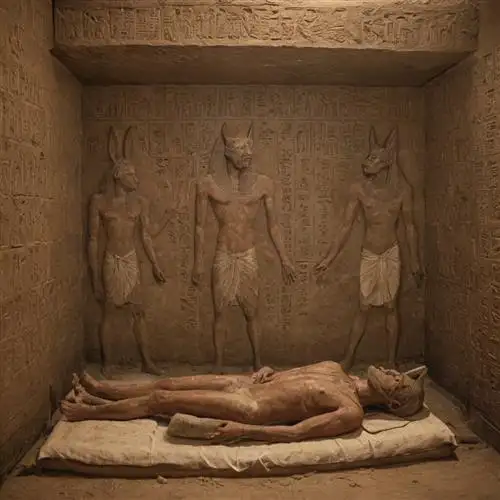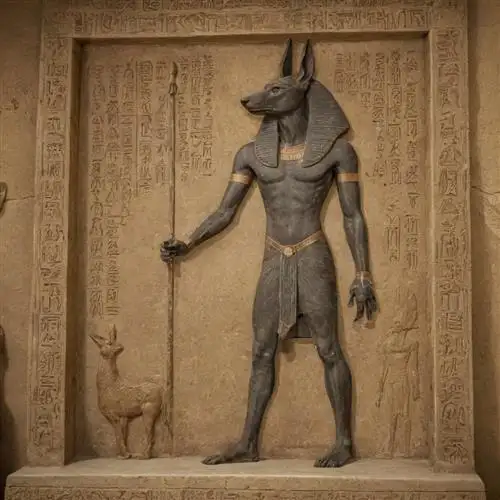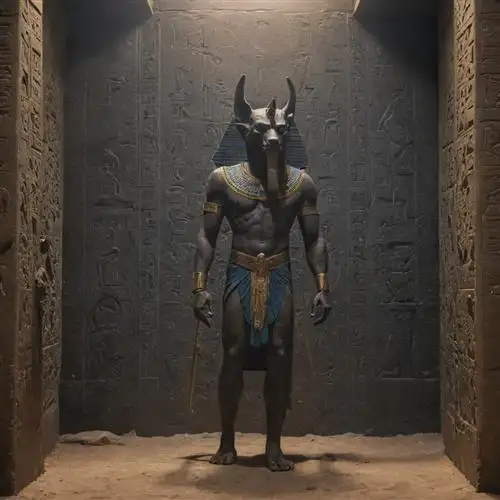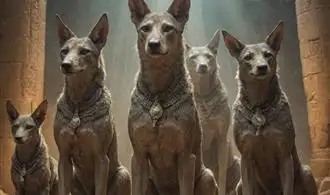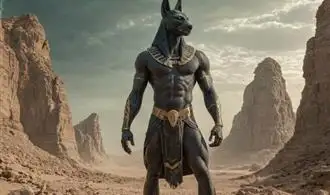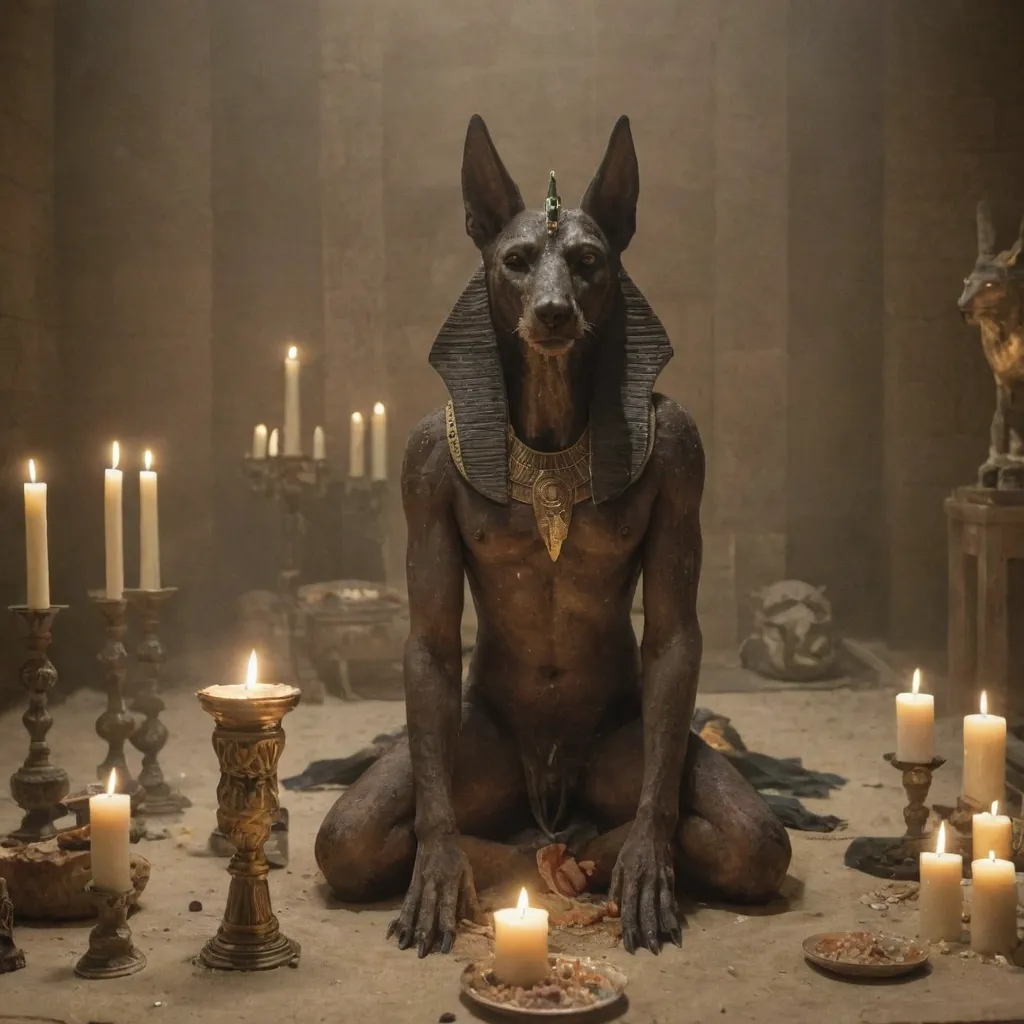
Anubis The Guardian of the Dead
Anubis, the jackal-headed deity, is a revered figure in ancient Egyptian mythology, known as the Guardian of the Dead. This powerful deity played a crucial role in the afterlife journey of the departed, guiding them through the treacherous realms of the underworld and ensuring their safe passage to the afterlife.
As the Guardian of the Dead, Anubis was responsible for the embalming and mummification process, ensuring the preservation of the deceased's physical form. This meticulous task was crucial, as the Egyptians believed that the soul could only return to the body during the afterlife. Anubis meticulously oversaw every step of the mummification ritual, from the removal of the internal organs to the wrapping of the body in sacred linen.
Anubis also played a pivotal role in the final judgment of the deceased. During the weighing of the heart ceremony, Anubis would carefully balance the heart of the deceased against the feather of Ma'at, the goddess of truth and justice. If the heart was found to be pure and free of sin, the individual was granted passage to the afterlife. However, if the heart was deemed heavier than the feather, the individual was deemed unworthy and their soul was devoured by the devouring demon, Ammit.
In addition to his role in the afterlife, Anubis was also revered as a protector and guide for the living. Worshippers would often seek Anubis' guidance and protection during times of uncertainty or danger, believing that the jackal-headed deity would watch over them and help them navigate the challenges of the mortal realm.
Rituals and ceremonies honoring Anubis were an integral part of ancient Egyptian religious practices. These rituals often involved the creation of Anubis statues or masks, which were used in funerary rites and other sacred ceremonies. The faithful would make offerings to Anubis, such as food, incense, or precious materials, in the hopes of securing his favor and protection.
Embalming Rituals and the Role of Anubis
Anubis, the ancient Egyptian jackal-headed deity, held a central role in the complex and revered embalming rituals that prepared the deceased for the afterlife. As the god of mummification and the protector of the dead, Anubis' involvement in this sacred process was paramount, guiding the embalmers through the intricate steps required to ensure the preservation of the body.
The embalming rituals, performed by a specialized class of priests known as "Sem" or "Anmu," were a meticulously choreographed series of actions that transformed the deceased into an eternal, sacred vessel. Anubis' presence was invoked at every stage, from the initial cleansing and purification of the body to the final wrapping and placement of amulets and other protective talismans.
The role of Anubis in the embalming process was multifaceted. As the god of the dead, he was believed to oversee the transition of the soul from the physical realm to the afterlife. His jackal-like head and canine features were symbolic of his ability to traverse the boundary between the living and the dead, making him the perfect intermediary for this sacred task.
One of the most critical responsibilities of Anubis was the removal of the deceased's internal organs, a process known as evisceration. This delicate procedure involved the extraction of the heart, lungs, liver, and intestines, which were then placed in canopic jars, each guarded by a different deity. Anubis oversaw this crucial step, ensuring the preservation of the body and the safe passage of the soul.
Following the evisceration, the body was thoroughly cleaned, dried, and anointed with a variety of sacred oils and resins. Anubis' presence was felt throughout this process, as the embalmers invoked his name and sought his divine guidance to ensure the successful mummification of the deceased.
The final stage of the embalming ritual involved the wrapping of the body in linen bandages, a process that could take several weeks to complete. Anubis was believed to be present during this meticulous task, helping to guide the embalmers and ensuring the proper placement of amulets and protective talismans within the wrappings.
Funerary Rites and the Weighing of the Heart
In the realm of ancient Egyptian mythology, the figure of Anubis, the jackal-headed deity, held a pivotal role in the intricate funerary rites and the sacred process of the Weighing of the Heart. As the god of embalming and the guardian of the necropolis, Anubis oversaw the crucial transition from life to the afterlife, ensuring the deceased's passage into the realm of the divine.
The Weighing of the Heart ceremony was a central component of the Egyptian funerary rituals, where the deceased's heart was weighed against the feather of Ma'at, the goddess of truth and justice. This elaborate process was believed to determine the fate of the individual's soul, as a heart found to be lighter than the feather would signify a life lived in accordance with the principles of Ma'at, granting the deceased passage into the afterlife. Conversely, a heart found heavier than the feather would condemn the individual to oblivion.
Anubis, as the presiding deity of this sacred ritual, played a pivotal role in the proceedings. The jackal-headed god would guide the deceased through the underworld, ensuring the proper preparation of the body and the performance of the necessary funerary rites. He would then preside over the Weighing of the Heart, closely observing the process and recording the outcome, which would ultimately determine the individual's fate in the afterlife.
The significance of Anubis's role in the Weighing of the Heart ceremony cannot be overstated. As the gatekeeper to the afterlife, his presence and supervision were crucial to the successful transition of the deceased into the realm of the gods. The ancient Egyptians believed that Anubis's vigilance and judgment ensured the integrity of the process, safeguarding the balance between the individual's actions in life and their eternal destiny.
Anubis and the Guardianship of the Underworld
Anubis, the jackal-headed Egyptian deity, was revered as the guardian of the underworld and the protector of the deceased. His role in the afterlife was integral to the ancient Egyptians' beliefs and rituals. As the expert in this field, we delve into the intricate practices and beliefs surrounding Anubis and his guardianship of the underworld.
Anubis was primarily responsible for the embalming and mummification process, ensuring the preservation of the deceased's physical body. This was crucial, as the Egyptians believed the soul could only return to the body after death. Anubis presided over the ritual of the "opening of the mouth," a ceremony that allowed the deceased to breathe, speak, and partake in the offerings presented to them.
The role of Anubis extended beyond the embalming process. He was believed to guide the souls of the dead through the underworld, ensuring their safe passage to the afterlife. In the Hall of Judgment, Anubis would weigh the heart of the deceased against the feather of truth, determining their worthiness to enter the afterlife. This judgment process was a critical aspect of the ancient Egyptian belief system, as it determined the fate of the soul.
Anubis' guardianship of the underworld also involved protecting the deceased from various dangers and entities that threatened the journey to the afterlife. He was often depicted standing guard at the entrance to the underworld, ensuring the safe passage of the dead and preventing unauthorized access. Additionally, Anubis was believed to have the power to ward off evil spirits and malevolent forces that threatened the deceased in the afterlife.
In the rituals and ceremonies dedicated to Anubis, the ancient Egyptians sought to invoke his protection, guidance, and judgment. Offerings, prayers, and specific rituals were performed to ensure the deceased's successful transition to the afterlife under the watchful eye of Anubis. These practices were integral to the Egyptian belief system, as they were seen as essential for the deceased's continued existence and eternal life.
Anubis in Modern Occult and Magical Practices
Anubis, the ancient Egyptian deity associated with death, the afterlife, and mummification, has continued to capture the imagination of modern occult and magical practitioners. While the traditional rituals and ceremonies honoring Anubis have been well-documented, the integration of this powerful entity into contemporary spiritual and magical practices deserves closer examination.
Within the realm of Wicca and Neopaganism, Anubis is often invoked as a guide and protector during funerary rites and rituals focused on the transition between life and death. Practitioners may incorporate Anubic imagery, such as the jackal-headed figure, into their altars and sacred spaces to facilitate a deeper connection with the underworld and the mysteries of the afterlife. Some Wiccans also view Anubis as a guardian of the initiatory process, welcoming and guiding initiates through the transformative experiences that are integral to their spiritual journeys.
In Hermetic and ceremonial magic traditions, Anubis is often invoked as a powerful psychopomp, or guide of souls, during ritual workings aimed at exploring the subconscious, the astral plane, or the realms of the dead. Practitioners may use Anubic symbolism and imagery, such as the ankh or the jackal-headed staff, to focus their intentions and enhance their connection with the deity during invocations, evocations, or pathworking exercises. The association of Anubis with mummification and the preservation of the physical body has also led to the incorporation of Anubic elements in rituals and spellwork focused on healing, protection, and spiritual transformation.
In the realm of Chaos magic, Anubis is sometimes viewed as a potent archetypical figure, representing the transformative power of death and the cyclical nature of existence. Chaos magicians may work with Anubic sigils, servitors, or egregores to tap into the deity's energies and use them to facilitate their own transformative experiences or to influence the world around them. The adaptability and open-ended nature of Chaos magic allows practitioners to work with Anubis in highly individualized ways, incorporating the deity's symbolism and energies into their own unique magical practices.
In addition to the integration of Anubis into various occult and magical traditions, the deity has also found a place in the burgeoning field of modern polytheism and devotional practices. Individuals drawn to the mysteries of the Egyptian pantheon may engage in regular devotional work, such as connecting with the Anubis deity without formal rituals, offering prayers and libations, or incorporating Anubic iconography into their personal altars and shrines. This approach allows for a more personal and direct relationship with the deity, fostering a sense of spiritual kinship and understanding.


